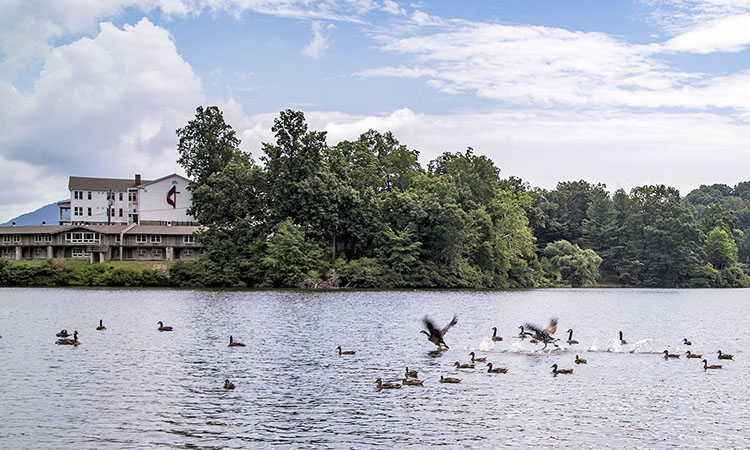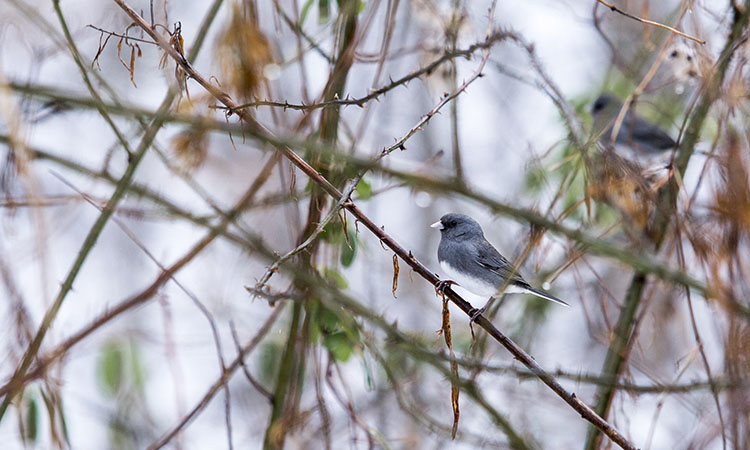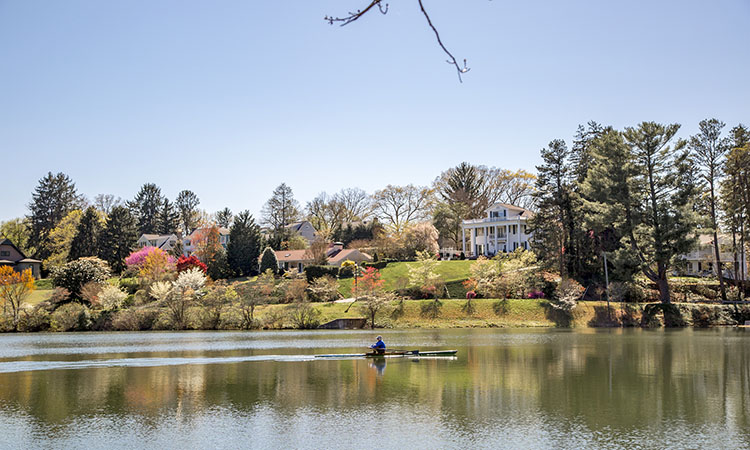Last Updated on May 4, 2023
Western North Carolina is home to a variety of outdoors activities, from mountain hiking and professional biking to lazy days tubing down the river. One activity that’s becoming more popular every day is birding. With our mountainous topography and four-season climate, there’s no better place to see such a wide variety of birds. In fact, many rare and exciting species call WNC home for at least a portion of the year.
If you’re keen to learn more about birding in WNC, we have all the details you need. Local experts answer our questions about the rise in popularity of bird watching in Asheville. And we share 10 of the top bird watching spots in WNC below.
What is birding?
Birding is simply the hobby of observing birds in their natural habitat. Birding can be done with the naked eye or by using visual enhancement devices like binoculars and telescopes. Some birders also choose to identify birds by their calls.
The main difference between birding and bird watching (when one is distinguished) is that “bird-watchers look at birds [and] birders look for them.” Our bird watching experts did not make the distinction in their everyday conversation, so the terms are used interchangeably for the purpose of this article.
How popular is bird watching in WNC?
“Bird watching is, surprisingly to a lot of people, the fastest growing hobby in North America, way out-competing golf and soccer, and all these other activities—even gardening, now,” says Simon Thompson of Wild Birds Unlimited and Ventures Birding Tours. “The Fish and Wildlife Service has estimated that over 50 million people now actively feed or watch birds, which is quite extensive and growing. It’s great to see so many people going out and enjoying the outdoors.”
What makes birding in WNC unique?
“I think [WNC is] probably one of the finest birdwatching and nature spots, gosh, certainly in the country, that I’ve visited,” says Thompson. “You [reach] almost 7,000 feet in elevation in the Blue Ridge, where if it’s 90 degrees, you can enjoy the relatively cool temperatures.”
“These high elevations mean that the birds towards the top of our Blue Ridge are actually birds of the Canadian eco-zone,” continues Thompson. “So, a lot of these birds are found nowhere else here in the South—which makes the whole area, from a naturalist’s point of view, a superb area to base yourself.”
And Thompson isn’t the only birder to sing our area’s praises.
“Western North Carolina offers outstanding birding,” says Tom Tribble, president of the Blue Ridge Audubon Society. “It is a flyway for migrating birds, and we get migrating birds coming up in the spring, and going south in the winter. So, the Western North Carolina mountains are a wonderful place to bird.”
WNC residents are fortunate to live in such a rich ecosystem. Many birders around the country have to travel to see the variety of species we have right here at home.
“I used to travel to go to birding sites, but I’ve found that here I don’t need to travel very far,” continues Tribble. “I can go up on the Blue Ridge Parkway and be there in 15 minutes. Or I can be here at the Beaver Lake Bird Sanctuary in three minutes. So, I’ve really enjoyed the birding in the mountains. Lots of species, in fact, [live] in this little sanctuary—we’ve had more than 190 species of birds seen right here.”
Is birding a tourist draw in WNC?
While it doesn’t get the same attention as other mountain sports—or leaf peeping—birding does attract many to our area to visit or stay.
“In Western North Carolina, because it’s such a good birding area, I think we’re getting more and more birders that are coming to the mountains just to see birds,” says Tribble. “We see people from out of the state, and also from the Piedmont and coastal regions of North Carolina. People come here for the leaves, but people also come here for the birding. And there are an incredible number of other attractions, but I stay here for the birds.”
Where are the 10 best bird watching spots in Asheville and WNC?
It’s not just people who love our moderate temperatures and lush vegetation. There are many great spots to go birding in Asheville and across Western North Carolina. Want to see what all the fuss is about? Here are 10 of our favorite locations for birding across WNC:
1. Beaver Lake Bird Sanctuary (Asheville)
This location lives up to its name! Managed by the Blue Ridge Audubon Society, the eight-acre sanctuary along Beaver Lake includes half uplands and half wetlands, with a convenient and accessible boardwalk loop. The roadside location attracts waterfowl, migrating species in spring and fall, and a variety of breeding birds.
Birds to Watch: Yellow Warbler, Gray Catbird, Blue‐gray Gnatcatcher, Great Blue Heron, Green Heron, Brown‐headed Nuthatches, Chimney Swift, Baltimore and Orchard Orioles, Eastern Kingbird, Warbling Vireo
2. Biltmore Estate (Asheville)
Annual passes to Biltmore are a must for avid bird watchers. The 8,000 acres of farmland, meadow, woods, and parkland surrounding the estate and development are a prime spot for warblers and waterfowl. Close to the road, try the gardens, bass pond, and Deer Park Trail.
Birds to Watch: Double-crested Cormorant, Osprey, Blue Grosbeak, Baltimore and Orchard Orioles, Eastern Kingbird, Yellow-billed Cuckoo, Eastern Bluebird, Eastern Meadowlark, Wood Duck, American Woodcock, Pine Warbler, Hooded Warbler, Scarlet Tanager, Red-eyed Vireo, Indigo Bunting, Carolina Chickadee, Tufted Titmouse, Golden-crowned Kinglet, Wild Turkey, Red-tailed Hawk, Great-horned and Eastern Screech-Owls
3. Blue Ridge Parkway
Curling 469 miles through the Blue Ridge Mountains, the aptly named Blue Ridge Parkway is a haven of fantastic views and hiking opportunities. It’s also home to more than 250 bird species. Access the Parkway from Asheville, or head west to the Balsams near Waynesville or north toward Mt. Mitchell for additional birding locales.
Birds to Watch: Red-breasted Nuthatch, Black-throated Green Warbler, Golden-crowned Kinglet and Canada Warbler, Northern Saw-whet Owls, American Kestrels, Great Blue Herons, Wood Ducks, Kingfishers, Sandpipers, Bitterns, Great Egrets, Cerulean Warblers, Peregrine Falcons, Appalachian Yellow-bellied Sapsucker
4. Chimney Rock State Park (Chimney Rock)
This 1,000-acre park in the heart of Hickory Nut Gorge attracts birds from the low-lying riverbanks to the heights of Chimney Rock. Four easy-to-moderate hiking trails and a 404-foot waterfall make exploring nature fun. And kids will enjoy the live Birds of Prey program.
Birds to Watch: Peregrine Falcon, Broad-winged Hawks, Sharp-shinned Hawks, Cooper’s Hawks, Red-shouldered Hawks, Yellow and Yellow-throated Warbler, Belted Kingfisher, Scarlet Tanager, and as many as 15 species of warbler and vireo
5. French Broad River Greenway (Asheville)
Linking three of Asheville’s city parks along the second oldest river in the world, the French Broad River Greenway also winds through residential and commercial districts. Even so, many migrating songbirds stop through to watch locals kayak to New Belgium Brewing Company and other riverside stops.
Birds to Watch: Yellow-rumped and Blackpoll Warblers, Cliff Swallow, Yellow-throated Warbler, Warbling Vireo, Baltimore Oriole, Wilson’s Snipe
6. Great Smoky Mountains National Park
More than 240 species of birds have been found in Great Smoky Mountains National Park, including 60 year-round residents. The others migrate from as far as Canada and the neo-tropics to forage and breed in the park’s variety of elevations and microclimates.
Birds to Watch: Common Raven, Black-capped Chickadee, Canada Warbler, Brown Creeper, Dark-eyed Junco, Golden-crowned Kinglet, Northern Saw-whet Owl, Red-breasted Nuthatch, Winter Wren, Wild Turkey, Pileated Woodpecker, Orchard Oriole, Blue Grosbeak, Ruffed Grouse, Acadian Flycatcher, Willow Flycatcher, Yellow-throated Warbler, Hooded Warbler
7. Jackson Park (Hendersonville)
Conveniently located near downtown Hendersonville, the 212-acre Jackson Park features a variety of habitats attractive to migrating birds. The Blue Ridge Audubon Society suggests checking out the Nature Trail and the trails that follow the various waterways located along the park.
Birds to Watch: Rose‐breasted Grosbeak, Scarlet Tanager, Connecticut Warblers, Wilson’s Warblers, Mourning Warblers, Gray‐cheeked Thrush, Black‐billed Cuckoo, Yellow‐bellied Flycatcher, Sora and Virginia Rail, Yellow Warbler, Willow Flycatcher
8. Lake Junaluska
The 200-acre Lake Junaluska is ringed by Lakeshore Drive and walkways. There are plenty of opportunities to spot a variety of waterbirds attracted to the lake. Enjoy panoramic views from the Aquatic Center or stroll along the water for an up-close view.
Birds to Watch: Pied-billed Grebe, American Coot, Lesser Scaup, Hooded Merganser, Ring-necked and Ruddy Ducks, Ring-billed and Bonaparte’s Gulls, Common Loon, Blue-winged and Green-winged Teal, Gadwall, Wood Duck, Redhead Merganser, Bufflehead Merganser, Red-breasted Merganser, Greater Scaup, Common Goldeneye, Horned Grebe, Caspian and Forster’s Terns
9. North Carolina Arboretum (Asheville)
Don’t miss this center for education, research, and conservation. The public 434-acre North Carolina Arboretum is located within the Bent Creek Experimental Forest. Stop at the Baker Exhibit Center upon arrival to pick up a Trail and Gardens Map and bird list. Head to the Stream Garden, Nature Garden Trail, and National Native Azalea Repository for bird watching.
Birds to Watch: Yellow-bellied Sapsucker, Blue-headed Vireo, Black-throated Green Warbler, American Redstart, and more
10. Carl Sandburg Home National Historic Site (Flat Rock)
This 264-acre site was once home to poet, author, and bird watcher Carl Sandburg. The site includes 22 historic buildings, 40 acres of pasture, two small lakes, and several miles of wooded trails. Over 120 species of birds have been spotted on the estate, continuing Sandburg’s tradition as an avid bird watcher.
Birds to Watch: Ovenbird Warblers, Pine Warblers, Yellow-throated Warblers, Hooded Warblers, Black-and-white Warblers, Scarlet Tanager, Red-eyed Vireo, Indigo Bunting, Winter Wren, White-throated and Fox Sparrows, Hermit Thrush, Ruby-crowned and Golden-crowned Kinglets, Green Heron
What’s the best way to get started with bird watching?
Beginning bird watching doesn’t take much more than a little know-how and patience. But if you’re not sure where to start, the Blue Ridge Audubon Society hosts regular bird walks. All informational bird outings are free of charge and open to the public.
Looking for more information about birding in WNC? Visit Ventures Birding Tours at birdventures.com and the Blue Ridge Audubon Society at blueridgeaudubon.org.






